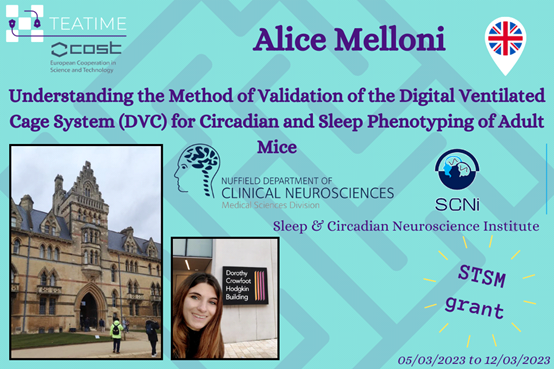
Details of the STSM
Title: Understanding the Method of Validation of the Digital Ventilated Cage System (DVC) for Circadian and Sleep Phenotyping of Adult Mice
Start and end date: 05/03/2023 to 12/03/2023
Host: Sleep and Circadian Neuroscience Institute (SCNi), Nuffield Department of Clinical Neurosciences, University of Oxford, England
Host website: https://www.ndcn.ox.ac.uk/research/sleep-circadian-neuroscience-institute
Description of the work carried out during the STSM
During the STSM, Prof Peirson showed me his group’s laboratory, the animal facility, and the setups dedicated to the behavioral tests. A particular attention was dedicated to the capacitive sensor board provided by Tecniplast S.p.A. for the validation of the correspondence between Digitalized Ventilated Cage (DVC) – recorded signals and the electroencephalographic (EEG) / electromyographic (EMG) recordings obtained with a traditional tethered system. In many home cage monitoring systems, validation of data against EEG is difficult due to the recording requirements of tethered EEG or telemetry EEG biopotentials within the home cage. This was a crucial part of the STSM and it was really helpful to give me the possibility to carry out a comparable data collection in the future, able to strengthen the validity of the current correlation analysis. I have been shown part of the raw data collected with this combined system and the criteria with which the analysis is operated.
Prof Peirson and his group have a significant experience in the fields of sleep, circadian rhythms, and light. Several hours were dedicated to discussing these topics, with a particular focus on the impact of light on rodent studies and possible experimental biases deriving from operators’ unawareness of light impact on animals’ behavior. I have been shown the tools for measuring light intensity in order to choose the most appropriate illumination source and level for rodents in experimental and housing conditions. I also had the opportunity to assist to several ongoing behavioral tests and experiments concerning circadian rhythms.
Finally, I presented my PhD project at Prof Peirson’s group weekly lab meeting. I received useful feedback and comments. Since my project includes some behavioral tests that are performed in his lab too, we also discussed about protocols and setups in the view of harmonising the way the tests are carried out in our laboratories.